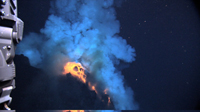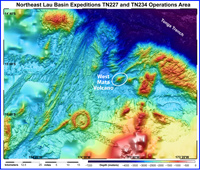 |

For further information, contact the MBL Communications Office at (508) 289-7423 or e-mail us at comm@mbl.edu
For Immediate Release: December 21, 2009
Contact: Gina Hebert, MBL, 508-289-7725; ghebert@mbl.edu
MBL Scientist Helps Discover Deep-Ocean Volcano, Finds Thriving Population of Extreme Microbes
 |
 |
 |
Resources:
NOAA press release
Julie Huber Lab

Julie Huber. High resolution.

Watch the video: (Quicktime)
ROV Jason gets a close view of magma explosions and lava flows on West Mata volcano (May 2009). (Credit: NOAA and NSF)
PHOTOS:

West Mata Volcano (white ellipse on bathymetric map) is not the largest volcano in the northeast Lau Basin, but appears to be the most active. Map represents the area visited and mapped on two recent expeditions. Summit of West Mata Volcano is nearly one mile deep, the base is nearly two miles deep. Tonga Trench (north and east of the expedition area) is nearly seven miles deep.
High resolution (Credit: NOAA)

Superheated molten lava, about 2,200 degrees Fahrenheit, is about to explode into the water in this image. The area in view is about 6-10 feet across in an eruptive area approximately the length of a football field that runs along the summit.
High resolution (Credit: NOAA and NSF)
|
MBL, WOODS HOLE, MA—Although MBL microbial oceanographer Julie Huber has logged over 10 months at sea exploring the deep ocean, she was unprepared for the spectacular underwater display that she and her colleagues experienced last May on a research cruise in the Western Pacific. There they discovered the eruption of the West Mata volcano, the deepest erupting volcano ever observed or imaged. West Mata sits 4,000 feet below the surface of the ocean, is located in an area bounded by Fiji, Tonga, and Samoa.
Huber and her colleagues described the discovery at the recent American Geophysical Union conference in San Francisco. “Seeing the planet form right before my eyes was absolutely spectacular,” says Huber. “There were molten lava bombs being thrown up into the water column, large billows of ash and smoke, and huge amounts of glowing lava.”
The eruption, which was captured on high-definition video, provided scientists with the first observation of an active formation of deep-ocean seafloor. The scientists also found flowing Boninite lava, which previously had only been found on extinct volcanoes more than a million years old, and shrimp thriving in the acidic water near the eruption.
But for Huber, perhaps the most exciting part of the expedition was the opportunity to sample the hot fluids surrounding the volcano for microbial life. “Water from the volcano was very acidic, and some samples collected directly above the eruption were as acidic as battery acid,” said Huber. “But we found microbes even in these extreme conditions. It is amazing that life can survive here.”
Huber’s preliminary results indicate that the microbes she and her colleagues collected are dominated by bacteria, but at relatively low diversity compared to other vent sites studied to date, suggesting that the microbial community at the West Mata volcano may be at the early stages of development. Alternatively, the harsh unstable conditions at the volcano may simply be too much for most microbes.
Huber and her colleagues believe further study of active eruptions will provide a better understanding of how heat and matter are transferred from the interior of the Earth to its surface, and how life adapts to some of the harshest conditions on earth. She hopes to return to the site in 2011 to see how the microbial communities have changed, and, in the meantime, will work on isolating and characterizing some of the microbes they were able to sample from the volcano.
Huber’s research was funded by the National Science Foundation.
The MBL is a leading international, independent, nonprofit institution dedicated to discovery and to improving the human condition through creative research and education in the biological, biomedical and environmental sciences. Founded in 1888 as the Marine Biological Laboratory, the MBL is the oldest private marine laboratory in the Americas. For more information, visit www.MBL.edu.
|